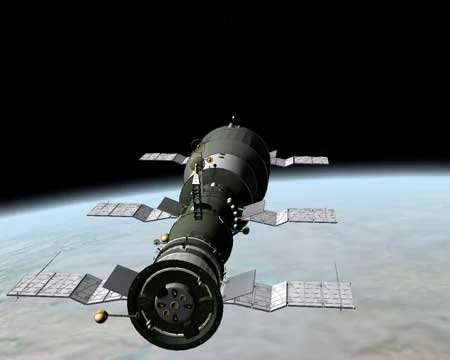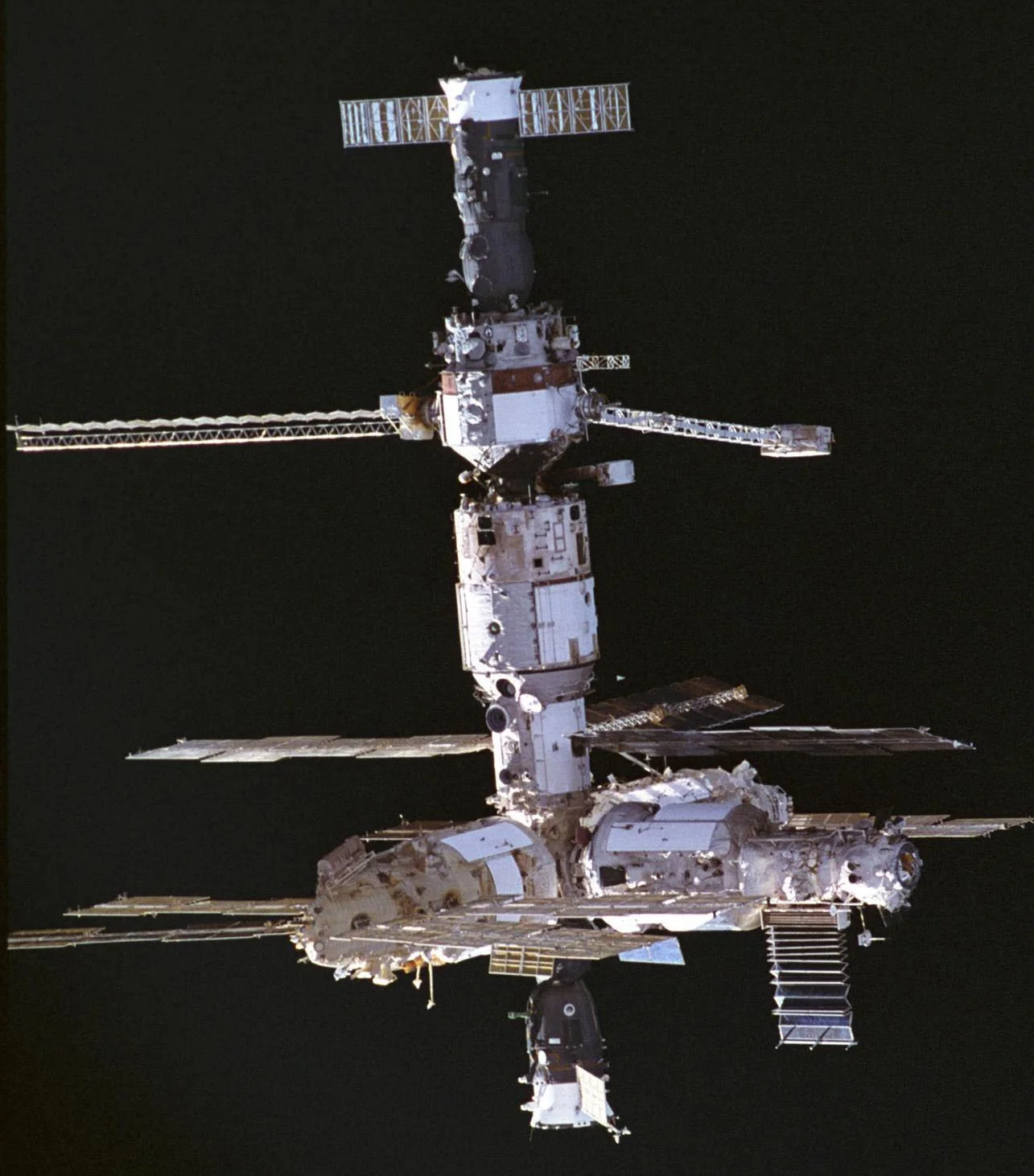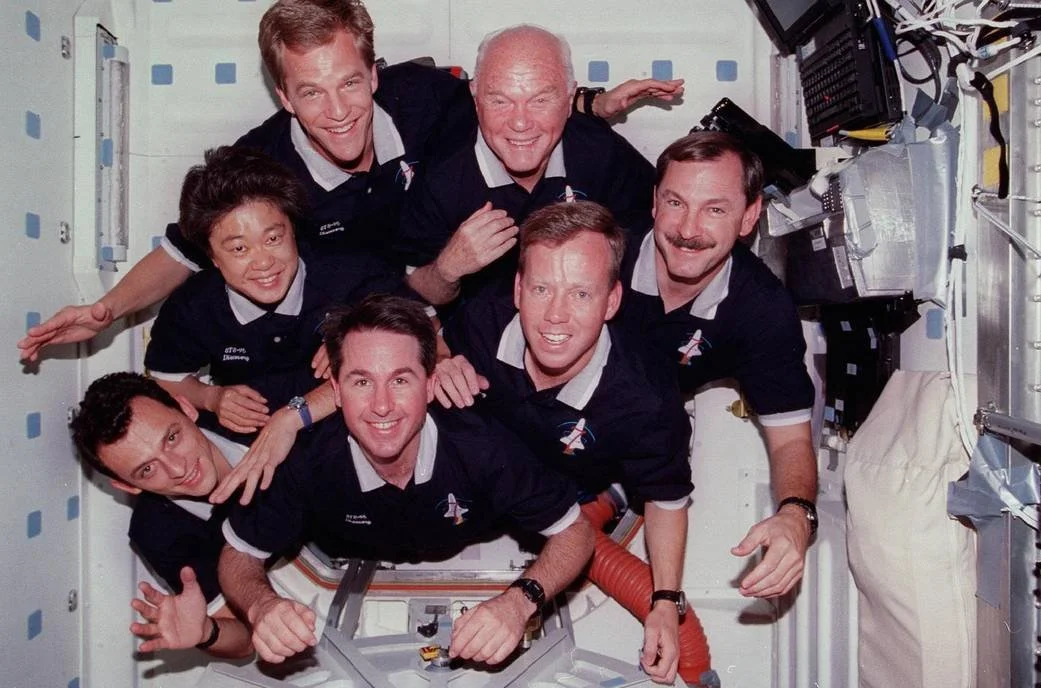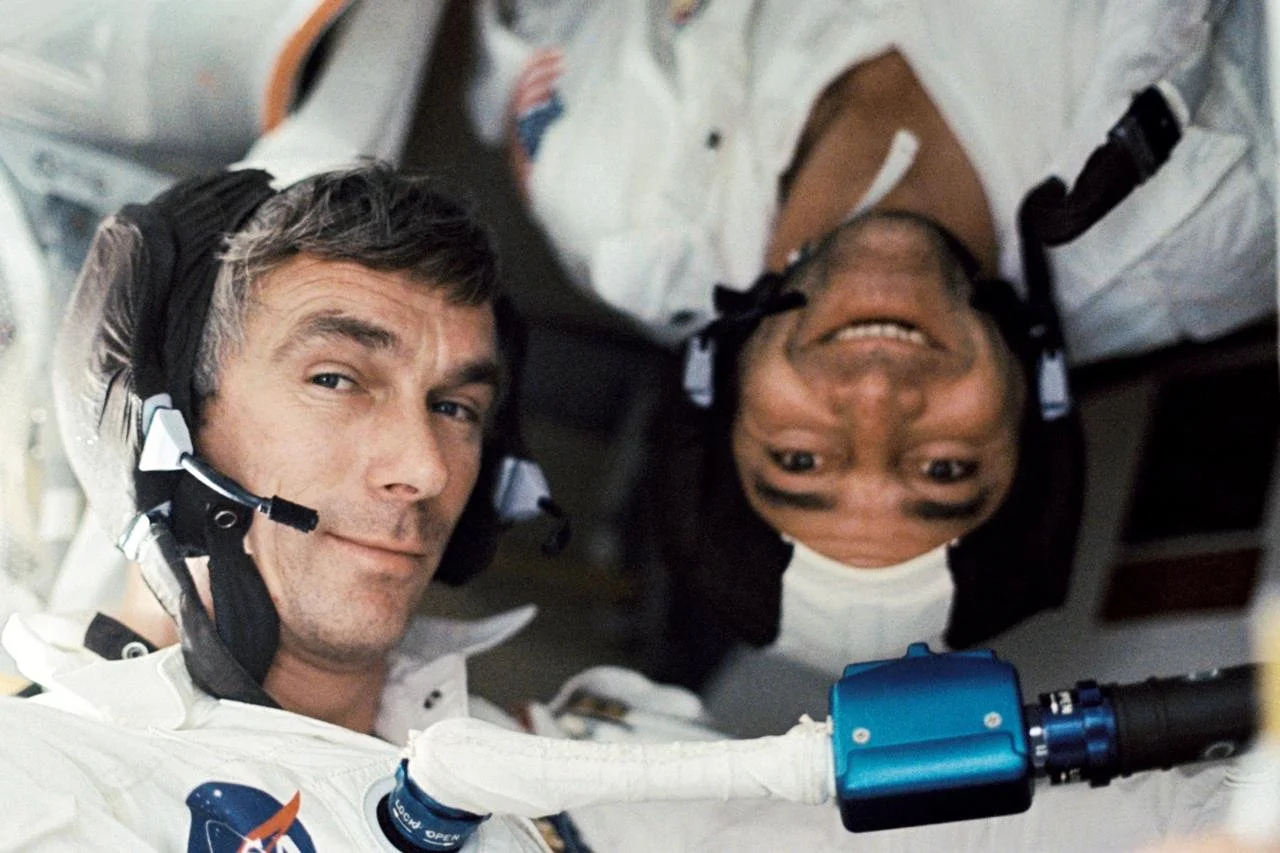
Living in Space
Prelude to the
International Space Station (ISS)
The Soviet’s first space station program, Salyut, 1971.
The first space station from the U.S., Skylab, 1973. Image credit: NASA
Russian Mir Space Station as seen from the Orbiter Atlantis on November 1, 1995. Image credit: NASA
This computer-generated artist's rendering of the International Space Station reflects its external appearance as of May 28, 2013. Soyuz 35 (TMA-09M) docks to Rassvet. Soyuz 34 (TMA-08M) is docked to Poisk. Progress 50 is docked to Pirs. Progress 51 docks to Zvezda aft. Image credit: NASA
The Soviet’s first space station program, Salyut, launched in 1971. The Salyut program taught them a lot about maintaining a crew in space and led to other developments in future space station programs.
Not one to be out done, the United States sent its own space station into orbit. Skylab launched in 1973 using leftover parts from the Apollo program. The workshop area was created out of an unused third stage of the Saturn V rocket. There were three manned crews assigned to Skylab and each crew stayed at the station progressively longer, teaching NASA about the effects of long-duration space exploration.
The first tentative step toward cooperation between the U.S. and the Soviets occurred in 1975. The Apollo Soyuz Test Project saw the US and Soviet Union meet together in space where the two spacecrafts docked and the astronauts and cosmonauts met in the middle with what became a famous handshake. The crews spent almost two days together, performing experiments, practicing docking maneuvers and visiting each other’s spacecrafts.
Soviet Soyuz spacecraft in orbit as seen from American Apollo spacecraft during the Apollo Soyuz Test Project on July 17, 1975. Image credit: NASA
Meanwhile the Soviets continued their space station program. Salyut led to Mir, another Soviet space station. Mir was planned to have a lifetime of five years and it lasted 15. In fact, it outlasted the Soviet Union. Mir was in orbit from 1986 to 2001. The USSR dissolution was effective on December 26, 1991. Not only did Mir represent another step forward in long duration space exploration, but it was also another opportunity for collaboration between Russia and the United States. In 1993, the first of 11 cooperative missions was launched when STS-60 carried Russian cosmonaut Sergei Krikalev to Mir along with the Wake Shield Facility experiment and a SPACEHAB module. The American astronauts spent time in the Russian Soyuz craft and worked alongside their cosmonaut colleagues on Mir. In all, the joint project lasted for four years and included milestones such as the first joint spacewalk between the two nations. This was the perfect foundation for the next step in living in space.
The International Space Station partnership led directly to the International Space Station. In 1998, the first component of the ISS—the control module Zarya—was launched by Russia. A month later, the United States launched the connecting node, Unity. The two were linked in space by U.S. space shuttle astronauts.
The ISS development partners grew to include the European Space Agency, Japan Aerospace Exploration Agency, and the Canadian Space Agency. As a truly international effort, various pieces of the ISS were built in each country. Canada supplied the Mobile Servicing System, which helped assemble the space station and continues to play a critical role in maintaining the ISS.
“Curiosity is the essence of our existence.”
— Astronaut Gene Cernan
Conditions in Space
Space Shuttle STS-95 crew members pose in zero gravity. Image credit: NASA
Flight Engineer Christina Koch demonstrates how fluids behave in the weightless environment of microgravity aboard the International Space Station. Image credit: NASA
Astronauts Ronald Evans and Eugene Cernan under zero-gravity aboard Apollo 17. Image credit: NASA
Flight Engineers Andrew Morgan and Jessica Meir and Commander Oleg Skripochka demonstrate weightlessness on the International Space Station on March 29, 2020. Image credit: NASA
Living in space requires many of the same considerations as living on Earth. Astronauts must work, eat, sleep and exercise to stay healthy and to keep their space station running. Carrying out all those tasks in space, however, provides some unique challenges that are not at all like living on Earth.
First, there’s the challenge of microgravity. Imagine the astronaut floating above a work area, secured only by tethers or foot and hand holds. As they work on experiments (experiments on the ISS have led to advances in everything from cancer treatment to how to improve recycling processes), they must secure every tool they use, or they float away. Food can float away before it makes it into the astronaut’s mouth. While that seems funny, it can also cause problems if crumbs wind up getting into the delicate instrumentation. That is part of the reason salt, pepper and bread are banned on the ISS. The other reason is that tiny crumbs and particles might accidentally be inhaled by the astronauts. Gravity resolves all those problems on Earth where we simply sweep crumbs away.
Working outside the space station poses even more problems. Tethers are required to keep the astronauts from floating off into space and their heavy suits and gloves that are essential to protect them from radiation and to maintain the air pressure that keeps them alive are cumbersome and make even simple tasks like loosening a bolt extremely laborious.
“Spacesuits are so expensive because they’re complex, human-shaped spacecraft. Think about them in terms of spacecraft, not as work clothes. ”
Another condition most Earth-bound workers don’t consider is the risk of radiation. NASA has been studying the effects of radiation exposure in space since the early days of manned space exploration. Because the Earth’s atmosphere blocks some of the harmful radiation, it is not as great a concern as it is for the astronauts on the ISS, who are exposed to higher radiation levels. Very little is known about deep space radiation exposure; only the Apollo astronauts who went to the Moon were exposed to it. While the ISS astronauts are currently performing various experiments regarding radiation protection, the real test will come when the first group begins to live on the Moon.
“We do not realize what we have on Earth until we leave it.”
— Astronaut Jim Lovell
Working in Space
Astronaut Jessica Meir cuts mustard green leaves grown aboard the International Space Station. Image credit: NASA
Astronaut Clayton Anderson works with stowage bags on STS-117 Space Shuttle Atlantis. Image credit: NASA
Apollo 17 Astronaut Harrison Schmitt inside the Lunar Module on the Moon. Image credit: NASA
Ever since the early days of space exploration, astronauts have been performing experiments, including on themselves, to study the effects of microgravity. On the International Space Station (ISS), astronauts spend most of their time working on experiments, many that are helping to determine how astronauts will live and work on Mars. But that is not all the work they do. They are also the ISS maintenance crew, performing various tasks to make sure that the ISS continues to function and is a safe place for the crew to live.
“We’ve learned a lot by building the International Space Station, the good, the bad. But, the fact is is that working together as a team, unity aboard that space station, we can accomplish great things.”
Astronaut work is not limited to inside the spacecraft or space station. Since the Gemini era and to the present day, astronauts have been going outside the safety of their spacecraft to perform experiments, retrieve film canisters and fix things, like the Skylab solar panel or general maintenance on the ISS.
This footage was taken by U.S. astronaut Terry Virts during a spacewalk on the International Space Station on February 25, 2015. Video credit: NASA
“It's human nature to stretch, to go, to see, to understand. Exploration is not a choice, really; it's an imperative.”
— Astronaut Michael Collins
Eating in Space
Astronaut Edward T. Lu eats with chopsticks on the International Space Station (ISS). Image credit: NASA
Cosmonaut Valery G. Korzun eating on the International Space Station. Image credit: NASA
Apollo 17 Astronaut Eugene Cernan eating in weightless conditions. Image credit: NASA
Current astronaut food no longer comes in a tube, but it has the same principles as the early days of space flight: lightweight, compact, nutritious with a long shelf life.
An astronaut will eat three meals and one snack a day. Depending on body weight and gender, they eat 1900-3200 calories. Food is rehydrated, cut open and eaten out of the package. Occasionally, a supply ship will bring fresh fruits and vegetables to the ISS.
The Expedition 53 crew built their own pizzas for movie night on the ISS. Video credit: NASA
For future missions food will have to last for years while maintaining nutritional value. NASA is still unsure how radiation will affect the food quality. While astronauts aboard the International Space Station proved food can grow in space, it will take years to grow the amount and variety of food required to meet the astronaut’s full nutritional needs.
Astronaut Karen Nyberg prepares to eat a snack on the International Space Station (ISS).
“It’s easy to sleep floating around — it’s very comfortable. But you have to be careful that you don’t float into somebody or something!”
— Astronaut James Irwin
Sleeping in Space
Astronaut Eugene Cernan sleeping aboard Apollo 17 spacecraft. Image credit: NASA
Astronaut Daniel Tani sleeps about the International Space Station on November 2, 2007. Image credit: NASA
Astronaut Jim Lovell sleeps aboard Apollo 13. Image credit: NASA
Sleeping in space is difficult. There’s the comfort factor: astronauts are in tight quarters with no gravity to hold them in place. And there's the circadian rhythm factor: the sun doesn’t rise and set in its normal 24-hour period like on Earth.
Sleeping on the ISS. Video credit; NASA
Sleep is a very important component to a healthy and productive crew. NASA takes this very seriously, providing each astronaut with a private space to sleep. They sleep in sleeping bags, strapped to the wall or ceiling to prevent them from floating away. Each crew member has a scheduled sleep period. Studies in space and on Earth demonstrate that lack of sleep can be detrimental to quality of work, affecting reaction time, cognitive function, and increasing the likelihood of accidents. NASA is currently conducting experiments on Earth and in space to test how lack of sleep affects brain function.
Flight Engineer Samantha Cristoforetti prepares to sleep in her quarters on the International Space Station on December 6, 2014. Image credit: NASA
“When I first looked back at the Earth, standing on the Moon, I cried.”
— Astronaut Alan Shepard
Exercising in Space
Flight Engineer Tom Marshburn runs on the Combined Operational Load Bearing External Resistance Treadmill (COLBERT) 2 on the International Space Station (ISS) on December 24, 2012. Image credit: NASA
An important lesson from the space station age is the importance of exercise in space. The human body reacts to the lack of gravity. The muscles and bones no longer have to work as hard to support the body in weightlessness. The heart doesn’t have to work as hard to pump blood. Even with the required daily two-hour workout, astronauts still lose one percent of their bone density in a month. To combat all those conditions, astronauts perform a variety of exercises each day on specially adapted equipment like a treadmill and the ISS version of an exercise bike: the ergometer. And, just like on Earth, they also find ways to make fitness fun from having relay races to tennis and badminton matches.
Another thing exercise does is to help maintain the health of the immune system. Astronauts on the International Space Station are also currently studying how microgravity affects the immune system.
Expedition 52 flight engineer Peggy Whitson gives us a rapid-fire display of exercises that can be done with just one piece of equipment. Video credit: NASA
“The stars don’t look bigger.
But they do look brighter.”
— Astronaut Sally Ride
Hygiene in Space
Astronaut Serena Aunon-Chancellor performs plumbing duties inside the International Space Station's toilet. Image credit: NASA
Microbial Tracking-2 by the toilet on the International Space Station. Image credit: NASA
Going to the bathroom in space is a delicate issue. For early spaceflight the all-male crews used condom-style catheters attached to a bag for urine and fecal collection bags for defecation.
Once women began flying, their needs had to be addressed. NASA developed Disposable Absorption Containment Trunks, or DACTs, which is a large diaper. Women wore these during launch, re-entry, and spacewalks, when the shuttle or Station bathroom were not accessible. Men soon began using the DACT, as well.
The most common question asked of astronauts: How Do You Go To The Bathroom In Space? Video credit: NASA
The Artemis missions will combine the old with the new. The new spacesuit, the xEMU, used for spacewalks and moonwalks will still use the DACT, or similar device. The Orion spacecraft and Gateway space station will both have toilets.
























